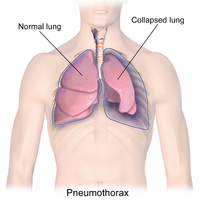
Photo from wikipedia
Abstract. Lung cancer has caused the most cancer deaths in the past several years. Benign–malignant lung nodule classification is vital in lung nodule detection, which can help early diagnosis of… Click to show full abstract
Abstract. Lung cancer has caused the most cancer deaths in the past several years. Benign–malignant lung nodule classification is vital in lung nodule detection, which can help early diagnosis of lung cancer. Most existing works extract the features of chest CT images using the well-designed networks, which require substantial effort of experts. To automate the manual process of network design, we propose an attention-guided differentiable architecture search (A-DARTS) method, which directly searches for the optimal network on chest CT images. In addition, A-DARTS utilizes an attention mechanism to alleviate the effect of the initialization-sensitive nature of the searched network while enhancing the feature presentation ability. Extensive experiments on the Lung Image Database Consortium image collection (LIDC-IDRI) benchmark dataset show that the proposed method achieves a lung nodule classification accuracy of 92.93%, which is superior to the state-of-the-art methods.
Journal Title: Journal of Electronic Imaging
Year Published: 2021
Link to full text (if available)
Share on Social Media: Sign Up to like & get
recommendations!